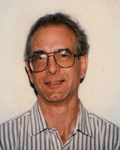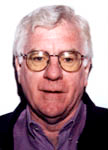
Vincent C. Hascall
Dr. Vincent Hascall received a Ph. D. from the Rockefeller University in 1969. His thesis research with his classmate, Dr. Stanley Sajdera, concerned the aggregating properties of the cartilage proteoglycan (now called aggrecan), and introduced the dissociative extraction procedures widely used to extract and purify proteoglycans from tissues and cells. After graduation, Dr. Hascall received a faculty appointment in the Departments of Biochemistry and Oral Biology at the University of Michigan. In 1975, he moved to the National Institute of Dental Research in Bethesda to direct research in the Proteoglycan Section. In 1994, Dr. Hascall received his current staff appointment in the Biomedical Engineering Department of the Lerner Research Institute at the Cleveland Clinic Foundation. His research contributions to connective tissue biology and glycobiology have been recognized by such honors as a Doctor of Medicine, honoris causa, from the University of Lund, Sweden; the Karl Meyer Award for Glycoconjugate Research from the Society for Complex Carbohydrates; and an Associate Editorship for the Journal of Biological Chemistry.

Masaki Yanagishita
Dr. Masaki Yanagishita received an M. D. from the Keio University, School of Medicine in 1973. After graduation, he started his clinical training as a resident in internal medicine in the Toranomon Hospital (Tokyo). His research career began in 1975 when he moved to the National Institute of Child Health and Human Development in Bethesda as a Visiting Fellow, where he met with Dr. Vincent Hascall and was fascinated by proteoglycan research. After a short return to the Toranomon Hospital to complete his clinical training in Endocrinology between 1979 and 1980, he moved back to Bethesda to join Dr. Hascall's lab and studied metabolism of proteoglycans especially on heparan sulfate proteoglycans. In 1996, he was appointed to the current position, Professor of the Department of Biochemistry, Tokyo Medical and Dental University, School of Dentistry.

Bryan P. Toole
Bryan Toole was educated in Melbourne, Australia, where he received a B.Sc. degree from the University of Melbourne and a Ph.D. in Biochemistry at Monash University. His Ph.D. work in the laboratory of Professor Dennis Lowther included the initial isolation and purification of the dermatan sulfate proteoglycan, now named decorin, and the first demonstration that decorin interacts with collagen under physiological conditions. In 1968, he moved to Boston for postdoctoral studies at Massachusetts General Hospital and Harvard Medical School in the laboratory of Dr. Jerome Gross. There Dr. Toole showed that hyaluronan surrounds and interacts with motile and proliferating cells during regeneration and embryonic development. In 1972, he joined the Harvard University faculty and established his own laboratory dedicated to the study of hyaluronan-cell interactions in embryonic development and cancer and to the biochemical characterization of hyaluronan receptors. In 1980, he joined the Tufts University Health Sciences Campus in Boston as Professor of Anatomy and Cellular Biology and from 1985 to 1992 was Chair of this Department. He is now the George Bates Professor of Histology and Director of the Ph.D. Program in Cell, Molecular and Developmental Biology at the Tufts Health Sciences Campus. His laboratory continues to focus on hyaluronan-cell interactions in morphogenesis and cancer, as well as on the role of tumor-stromal cell interactions in the regulation of matrix metalloproteinases during metastasis.
The Glycoforum website established by Seikagaku Corporation is celebrating its 10th year. The series "The Science of Hyaluronan Today" was an inaugural feature of the website that has continued to bring new insight into the multi-faceted, ever expanding biological and technological roles of this fascinating macromolecule. The series has been a valuable resource as indicated by the nearly one million visits it has received during the past year.
We are therefore very pleased that Seikagaku has asked that we continue to bring new information to this site through frequent "Updates" of former articles and the addition of new articles featuring the emerging frontiers of hyaluronan research. The recent 7th International Conference on Hyaluronan in Charleston, co-chaired by Bryan Toole and Vincent Hascall, provided an opportunity to learn the current state of the art for hyaluronan research and was an excellent launching point to initiate the second 10 year progression of this series. We hope that you will enjoy it and find it valuable as it continues to evolve.



The international conference on hyaluronan, Hyaluronan 2003, was an exciting crossroad demonstrating the exceptional importance of our favorite molecule in many aspects of the biology of higher organisms and some of our bacterial aggressors. This ensures that there will continue to be new, cutting-edge chapters for the foreseeable future in our Science of Hyaluronan website.
The website was initiated almost 6 years ago with the objective of summarizing the current status of different hyaluronan research areas in a form that would be accessible to a wide audience of researchers with diverse backgrounds. As is almost always the case, the current status of a novel, cutting edge research area advances into even newer, uncharted areas with additional time, and this is the case with a number of the contributions made to the website. Therefore, we have given the authors of the chapters from the first 2 years of the website an opportunity to prepare an Update. The intent of the Updates is to show what new things have happened in the interval between the original chapter and the present. The Updates will be placed immediately behind the original chapters in the website.
We are very happy to initiate the Update series with two by Paul Weigel "Bacterial Hyaluronan Synthases" and Robert Stern "The Mammalian Hyaluronidases" we look forward to many more in the future.
Seikagaku Corporation is celebrating its 50th anniversary, and as part of this event, is opening this web-site "glycoforum". Glycoforum is intended as a public service to present short articles on current, exciting research activities in glycobiology. These articles are intended to reach the wider research community and not solely the specialists in the particular subject matter being featured.
We are delighted that Seikagaku has chosen the topic of "The Science of Hyaluronan Today" as the first series for Glycoforum, and that we were asked to organize and edit it. This series will focus on one of the most fascinating macromolecules in nature, and one which is currently receiving a lot of attention from both the research and commercial sectors. The first article, which follows below, will introduce hyaluronan and provide a background for the articles to follow, approximately two every 3 months over the next 2 years. We hope that you will find these articles informative, interesting and entertaining. We welcome any comments or questions you may have about the articles in this series at any time.